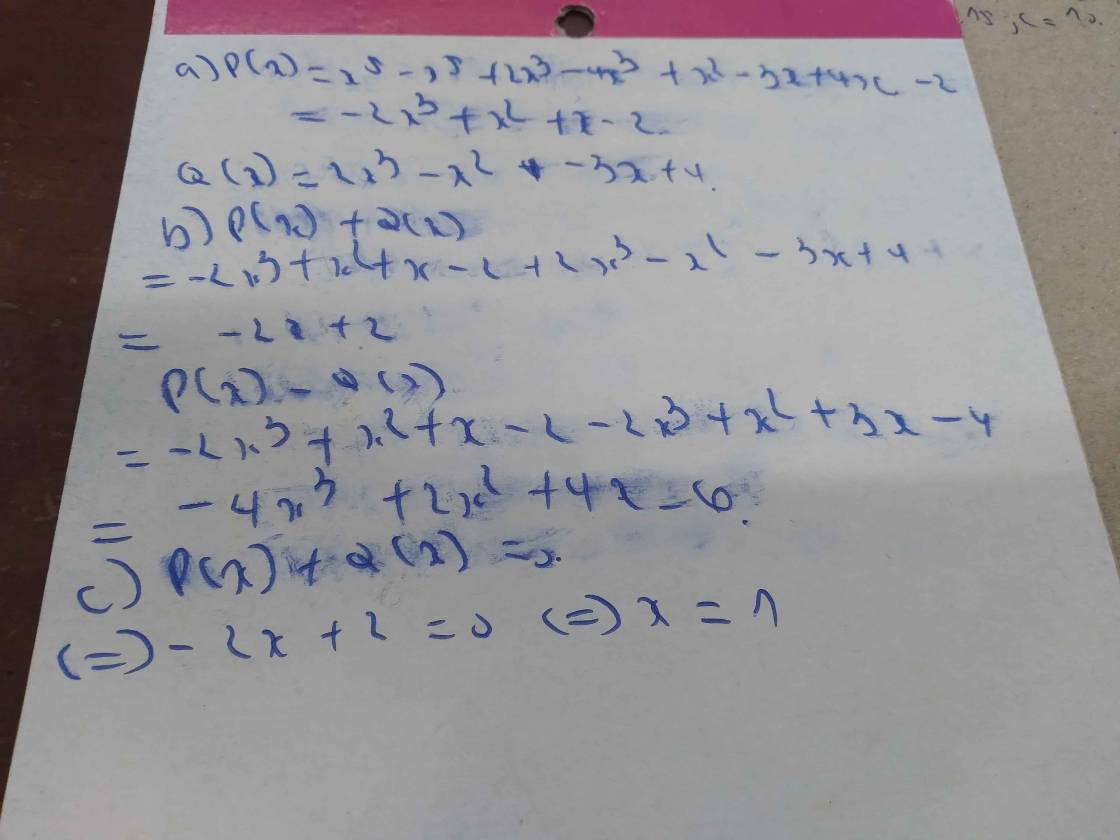Tính: (-2x2) . (3x – 4x3 + 7 – x2)

Những câu hỏi liên quan
Cho hai đa thức
P
(
x
)
2
x
3
-
3
x
+
x
5
-
4
x
3
+
4
x
-
x
5
+
x
2
-
2
;
Q
(
x
)...
Đọc tiếp
Cho hai đa thức
P ( x ) = 2 x 3 - 3 x + x 5 - 4 x 3 + 4 x - x 5 + x 2 - 2 ; Q ( x ) = x 3 - 2 x 2 + 3 x + 1 + 2 x 2
Tính P(x) - Q(x)
A. - 3 x 3 + x 2 - 2 x + 1
B. - 3 x 3 + x 2 - 2 x - 3
C. 3 x 3 + x 2 - 2 x - 3
D. - x 3 + x 2 - 2 x - 3
Ta có
P ( x ) = 2 x 3 − 3 x + x 5 − 4 x 3 + 4 x − x 5 + x 2 − 2 = x 5 − x 5 + 2 x 3 − 4 x 3 + x 2 + ( 4 x − 3 x ) − 2 = − 2 x 3 + x 2 + x − 2 Và Q ( x ) = x 3 − 2 x 2 + 3 x + 1 + 2 x 2
= x 3 + - 2 x 2 + 2 x 2 + 3 x + 1 = x 3 + 3 x + 1
Khi đó
P ( x ) − Q ( x ) = − 2 x 3 + x 2 + x − 2 − x 3 + 3 x + 1 = − 2 x 3 + x 2 + x − 2 − x 3 − 3 x − 1 = − 2 x 3 − x 3 + x 2 + ( x − 3 x ) − 2 − 1 = − 3 x 3 + x 2 − 2 x − 3
Chọn đáp án B
Đúng 0
Bình luận (0)
Với những giá trị nào của x thì a) x3-x2+3x-30b) x3+x2+9x+90c) 4x3-14x2+6x-210d) x2(2x2+3)+2x2-3
Đọc tiếp
Với những giá trị nào của x thì a) x3-x2+3x-3>0b) x3+x2+9x+9<0c) 4x3-14x2+6x-21<0d) x2(2x2+3)+2x2>-3
a) \(x^3-x^2+3x-3>0\)
\(\Leftrightarrow x^2\left(x-1\right)+3\left(x-1\right)>0\)
\(\Leftrightarrow\left(x^2+3\right)\left(x-1\right)>0\)
Mà: \(x^2+3>0\forall x\)
\(\Leftrightarrow x-1>0\)
\(\Leftrightarrow x>1\)
b) \(x^3+x^2+9x+9< 0\)
\(\Leftrightarrow x^2\left(x+1\right)+9\left(x+1\right)< 0\)
\(\Leftrightarrow\left(x^2+9\right)\left(x+1\right)< 0\)
Mà: \(x^2+9>0\forall x\)
\(\Leftrightarrow x+1< 0\)
\(\Leftrightarrow x< -1\)
d) \(4x^3-14x^2+6x-21< 0\)
\(\Leftrightarrow2x^2\left(2x-7\right)+3\left(2x-7\right)< 0\)
\(\Leftrightarrow\left(2x^2+3\right)\left(2x-7\right)< 0\)
Mà: \(2x^2+3>0\forall x\)
\(\Leftrightarrow2x-7< 0\)
\(\Leftrightarrow2x< 7\)
\(\Leftrightarrow x< \dfrac{7}{2}\)
d) \(x^2\left(2x^2+3\right)+2x^2>-3\)
\(\Leftrightarrow2x^4+3x^2+2x^2+3>0\)
\(\Leftrightarrow2x^4+5x^2+3>0\)
\(\Leftrightarrow\left(x^2+1\right)\left(2x^2+3\right)>0\)
Mà:
\(x^2+1>0\forall x\)
\(2x^2+3>0\forall x\)
\(\Rightarrow x\in R\)
Đúng 2
Bình luận (0)
a: =>x^2(x-1)+3(x-1)>0
=>(x-1)(x^2+3)>0
=>x-1>0
=>x>1
b: =>x^2(x+1)+9(x+1)<0
=>(x+1)(x^2+9)<0
=>x+1<0
=>x<-1
c: 4x^3-14x^2+6x-21<0
=>2x^2(2x-7)+3(2x-7)<0
=>2x-7<0
=>x<7/2
d: =>x^2(2x^2+3)+2x^2+3>0
=>(2x^2+3)(x^2+1)>0(luôn đúng)
Đúng 1
Bình luận (0)
Bài 1:Thực hiện các phép tính
a. (x5 +4x3 - 6x2):4x2
b. (x3 +x2-12) : (x-2)
c. (-2x5+3x2-4x3):2x2
d. (x3 - 64):(x2 + 4x + 16)
Bài 2:Rút gọn biểu thức
a. 3x (x - 2)- 5x (1 - x) - 8(x2 - 3)
b.(x - y) (x2 + xy + y2)+2y3
c. (x - y)2 + (x+y)2 - 2(x-y) (x+y)
Đọc tiếp
Bài 1:Thực hiện các phép tính
a. (x5 +4x3 - 6x2):4x2
b. (x3 +x2-12) : (x-2)
c. (-2x5+3x2-4x3):2x2
d. (x3 - 64):(x2 + 4x + 16)
Bài 2:Rút gọn biểu thức
a. 3x (x - 2)- 5x (1 - x) - 8(x2 - 3)
b.(x - y) (x2 + xy + y2)+2y3
c. (x - y)2 + (x+y)2 - 2(x-y) (x+y)
a) \(\left(x^5+4x^3-6x^2\right):4x^2\)
\(=\left(x^5:4x^2\right)+\left(4x^3:4x^2\right)+\left(-6x^2:4x^2\right)\)
\(=\dfrac{1}{4}x^3+x-\dfrac{3}{2}\)
b)
Vậy \(\left(x^3+x^2-12\right):\left(x-2\right)=x^2+3x+6\)
c) (-2x5 : 2x2) + (3x2 : 2x2) + (-4x^3 : 2x^2)
= \(-x^3+\dfrac{3}{2}-2x\)
d) \(\left(x^3-64\right):\left(x^2+4x+16\right)\)
\(=\left(x-4\right)\left(x^2+4x+16\right):\left(x^2+4x+16\right)\)
\(=x-4\)
(dùng hẳng đẳng thức thứ 7)
Bài 2 :
a) 3x(x - 2) - 5x(1 - x) - 8(x2 - 3)
= 3x2 - 6x - 5x + 5x2 - 8x2 + 24
= (3x2 + 5x2 - 8x2) + (-6x - 5x) + 24
= -11x + 24
b) (x - y)(x2 + xy + y2) + 2y3
= x3 - y3 + 2y3
= x3 + y3
c) (x - y)2 + (x + y)2 - 2(x - y)(x + y)
= (x - y)2 - 2(x - y)(x + y) + (x + y)2
= [(x - y) + x + y)2 = [x - y + x + y] = (2x)2 = 4x2
Đúng 0
Bình luận (0)
Bài 1 :
a]= \(\frac{1}{4}\)x3 + x - \(\frac{3}{2}\).
b] => [x3 + x2 -12 ] = [ x2 +3 ][x-2] + [-6]
c]= -x3 -2x +\(\frac{3}{2}\).
d] = [ x3 - 64 ] = [ x2 + 4x + 16][ x- 4].
Cho hai đa thức
P
(
x
)
2
x
3
−
3
x
+
x
5
−
4
x
3
+
4
x
−
x
5
+
x
2
−
2
;
Q
(
x
)
x
3
−
2
x
2
+
3
x
+
1
+...
Đọc tiếp
Cho hai đa thức
P ( x ) = 2 x 3 − 3 x + x 5 − 4 x 3 + 4 x − x 5 + x 2 − 2 ; Q ( x ) = x 3 − 2 x 2 + 3 x + 1 + 2 x 2
Tìm bậc của đa thức M(x) = P(x) + Q(x)
A. 4
B. 2
C. 3
D. 1
Ta có
P ( x ) = 2 x 3 − 3 x + x 5 − 4 x 3 + 4 x − x 5 + x 2 − 2 = x 5 − x 5 + 2 x 3 − 4 x 3 + x 2 + ( 4 x − 3 x ) − 2 = − 2 x 3 + x 2 + x − 2 Và Q ( x ) = x 3 − 2 x 2 + 3 x + 1 + 2 x 2 = x 3 + − 2 x 2 + 2 x 2 + 3 x + 1 = x 3 + 3 x + 1
Khi đó
M ( x ) = P ( x ) + Q ( x ) = − 2 x 3 + x 2 + x − 2 + x 3 + 3 x + 1 = − 2 x 3 + x 2 + x − 2 + x 3 + 3 x + 1 = − 2 x 3 + x 3 + x 2 + ( x + 3 x ) − 2 + 1 = − x 3 + x 2 + 4 x − 1
Bậc của M ( x ) = - x 3 + x 2 + 4 x - 1 l à 3
Chọn đáp án C
Đúng 0
Bình luận (0)
6). – x2 y(xy2 – 1/2 xy + 3/4 x2 y2 )7). (3xy – x2 + y). 2/3 x2 y8). (4x3 – 5xy + 2x)( – 1/2 xy)9). 2x2 (x2 + 3x + 1/2 )10). – 3/2 x4 y2 (6x4 − 10/9 x2 y3 – y5 )11). 2 3 x3 (x + x2 – 3/4 x5 )12). 2xy2 (xy + 3x2 y – 2/3 xy3 )13). 3x(2x3 – 1/3 x2 – 4x)14). 3/5 x3 y5 (7x4 + 5x2 y − 10/21 x4 y3 –y4 )
Đọc tiếp
6). – x2 y(xy2 – 1/2 xy + 3/4 x2 y2 )
7). (3xy – x2 + y). 2/3 x2 y
8). (4x3 – 5xy + 2x)( – 1/2 xy)
9). 2x2 (x2 + 3x + 1/2 )
10). – 3/2 x4 y2 (6x4 − 10/9 x2 y3 – y5 )
11). 2 3 x3 (x + x2 – 3/4 x5 )
12). 2xy2 (xy + 3x2 y – 2/3 xy3 )
13). 3x(2x3 – 1/3 x2 – 4x)
14). 3/5 x3 y5 (7x4 + 5x2 y − 10/21 x4 y3 –y4 )
6: \(-x^2y\left(xy^2-\dfrac{1}{2}xy+\dfrac{3}{4}x^2y^2\right)\)
\(=-x^3y^3+\dfrac{1}{2}x^3y^2-\dfrac{3}{4}x^4y^3\)
7: \(\dfrac{2}{3}x^2y\cdot\left(3xy-x^2+y\right)\)
\(=2x^3y^2-\dfrac{2}{3}x^4y+\dfrac{2}{3}x^2y^2\)
8: \(-\dfrac{1}{2}xy\left(4x^3-5xy+2x\right)\)
\(=-2x^4y+\dfrac{5}{2}x^2y^2-x^2y\)
Đúng 0
Bình luận (0)
9: \(2x^2\left(x^2+3x+\dfrac{1}{2}\right)=2x^4+6x^3+x^2\)
10: \(-\dfrac{3}{2}x^4y^2\left(6x^4-\dfrac{10}{9}x^2y^3-y^5\right)\)
\(=-9x^8y^2+\dfrac{5}{3}x^6y^5+\dfrac{3}{2}x^4y^7\)
11: \(\dfrac{2}{3}x^3\left(x+x^2-\dfrac{3}{4}x^5\right)=\dfrac{2}{3}x^3+\dfrac{2}{3}x^5-\dfrac{1}{2}x^8\)
12: \(2xy^2\left(xy+3x^2y-\dfrac{2}{3}xy^3\right)=2x^2y^3+6x^3y^3-\dfrac{4}{3}x^2y^5\)
13: \(3x\left(2x^3-\dfrac{1}{3}x^2-4x\right)=6x^4-x^3-12x^2\)
Đúng 0
Bình luận (0)
M(x) 3x3 + x2 + 4x4 – x – 3x3 + 5x4 + 2x2 – 6 N(x) - 2x2 – x4 + 4x3 – x2 -5x3 + 3x + 5 + xa) Thu gọn và sắp xếp đa thức M(x), N(x) theo lũy thừa giảm của biếnb) Xác định hệ số cao nhất, hệ số tự do, bậc của các đa thức M(x), N(x).c) Tính : M(x) + N(x)d) Tính N(x) – M(x)
Đọc tiếp
M(x) = 3x3 + x2 + 4x4 – x – 3x3 + 5x4 + 2x2 – 6
N(x) = - 2x2 – x4 + 4x3 – x2 -5x3 + 3x + 5 + x
a) Thu gọn và sắp xếp đa thức M(x), N(x) theo lũy thừa giảm của biến
b) Xác định hệ số cao nhất, hệ số tự do, bậc của các đa thức M(x), N(x).
c) Tính : M(x) + N(x)
d) Tính N(x) – M(x)
M(x) 3x3 + x2 + 4x4 – x – 3x3 + 5x4 + 2x2 – 6 N(x) - 2x2 – x4 + 4x3 – x2 -5x3 + 3x + 5 + xa) Thu gọn và sắp xếp đa thức M(x), N(x) theo lũy thừa giảm của biếnb) Xác định hệ số cao nhất, hệ số tự do, bậc của các đa thức M(x), N(x).c) Tính : M(x) + N(x)d) Tính N(x) – M(x)
Đọc tiếp
M(x) = 3x3 + x2 + 4x4 – x – 3x3 + 5x4 + 2x2 – 6
N(x) = - 2x2 – x4 + 4x3 – x2 -5x3 + 3x + 5 + x
a) Thu gọn và sắp xếp đa thức M(x), N(x) theo lũy thừa giảm của biến
b) Xác định hệ số cao nhất, hệ số tự do, bậc của các đa thức M(x), N(x).
c) Tính : M(x) + N(x)
d) Tính N(x) – M(x)
a) Ta có: \(M\left(x\right)=3x^3+x^2+4x^4-x-3x^3+5x^4+2x^2-6\)
\(=\left(4x^4+5x^4\right)+\left(3x^3-3x^3\right)+\left(x^2+2x^2\right)-x-6\)
\(=9x^4+3x^2-x-6\)
Ta có: \(N\left(x\right)=-2x^2-x^4+4x^3-x^2-5x^3+3x+5+x\)
\(=-x^4+\left(4x^3-5x^3\right)+\left(-2x^2-x^2\right)+\left(3x+x\right)+5\)
\(=-x^4-x^3-3x^2+4x+5\)
c) Ta có: M(x)+N(x)
\(=9x^4+3x^2-x-6-x^4-x^3-3x^2+4x+5\)
\(=8x^4-x^3+3x-1\)
Đúng 2
Bình luận (0)
P(x)=2x3-3x+x5-4x3+4x-x5+x2-2
Q(x)+2x3-2x2+3x+x2-6x+4
a)thu gọn và sắp xếp đa thức theo lũy thừa giảm dần của biến
b) tính P(x)+Q(x);P(x)-Q(x)
c)tìm nghiệm của đa thức P(x)+Q(x)
Cho biểu thức P 1+ 3/x2+5x+6 : ( 8x2/ 4x3-8x2 - 3x/ 3x2-12 -1/x+2)A) Rút gọn PB) Tìm các giá trị của x để P 0; P 1C) Tìm cã giá trị của x để P 0Cho biểu thứcQ (2x-x2/ 2x2 +8 - 2x2/ 3x3-2x2+4x-8) (2/x2 + 1-x/x)A) Rút gọn QB) Tìm giá trị nguyên của x để Q có giá trị nguyên
Đọc tiếp
Cho biểu thức P= 1+ 3/x2+5x+6 : ( 8x2/ 4x3-8x2 - 3x/ 3x2-12 -1/x+2)
A) Rút gọn P
B) Tìm các giá trị của x để P= 0; P= 1
C) Tìm cã giá trị của x để P> 0
Cho biểu thức
Q= (2x-x2/ 2x2 +8 - 2x2/ 3x3-2x2+4x-8) (2/x2 + 1-x/x)
A) Rút gọn Q
B) Tìm giá trị nguyên của x để Q có giá trị nguyên
Bài 1:
a) Ta có: \(P=1+\dfrac{3}{x^2+5x+6}:\left(\dfrac{8x^2}{4x^3-8x^2}-\dfrac{3x}{3x^2-12}-\dfrac{1}{x+2}\right)\)
\(=1+\dfrac{3}{\left(x+2\right)\left(x+3\right)}:\left(\dfrac{8x^2}{4x^2\left(x-2\right)}-\dfrac{3x}{3\left(x-2\right)\left(x+2\right)}-\dfrac{1}{x+2}\right)\)
\(=1+\dfrac{3}{\left(x+2\right)\left(x+3\right)}:\left(\dfrac{4}{x-2}-\dfrac{x}{\left(x-2\right)\left(x+2\right)}-\dfrac{1}{x+2}\right)\)
\(=1+\dfrac{3}{\left(x+2\right)\left(x+3\right)}:\dfrac{4\left(x+2\right)-x-\left(x-2\right)}{\left(x-2\right)\left(x+2\right)}\)
\(=1+\dfrac{3}{\left(x+2\right)\left(x+3\right)}\cdot\dfrac{\left(x-2\right)\left(x+2\right)}{4x+8-x-x+2}\)
\(=1+3\cdot\dfrac{\left(x-2\right)}{\left(x+3\right)\left(2x+10\right)}\)
\(=1+\dfrac{3\left(x-2\right)}{\left(x+3\right)\left(2x+10\right)}\)
\(=\dfrac{\left(x+3\right)\left(2x+10\right)+3\left(x-2\right)}{\left(x+3\right)\left(2x+10\right)}\)
\(=\dfrac{2x^2+10x+6x+30+3x-6}{\left(x+3\right)\left(2x+10\right)}\)
\(=\dfrac{2x^2+19x-6}{\left(x+3\right)\left(2x+10\right)}\)
Đúng 0
Bình luận (0)
















